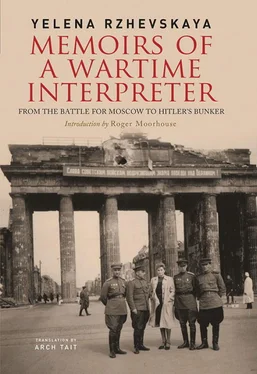Night in Berlin
The centre of Berlin was ablaze, and huge tongues of fire leapt skywards. The multistorey buildings they lit up seemed very close, but were in reality kilometres away. Great beams of light from searchlights swept the sky. The dull rumble of never-ending artillery fire reached our ears. Here the suburbs were still bristling with enemy anti-tank traps, but our tanks were already thundering towards the centre.
And this very night, in the catacombs beneath the Reich Chancellery, Adolf Hitler married Eva Braun. When later I learned this, I recalled the collapsing walls of burnt-out buildings, the acrid smell of charred ruins, the grim tank traps no longer capable of protecting anyone from anything, and in the darkness the inexorable thunder of tanks rushing towards the centre of Berlin, to the Reichstag and the Reich Chancellery.
I sat on an abandoned empty oil drum in a suburban street outside a boarded-up shop window, under a signboard whose gold letters proclaimed it to be a patisserie, Franz Schulz Feinbäckerei, waiting to hear from headquarters where we were to go. That night the front line ran through the centre of Berlin. From time to time there were flashes of artillery fire.
I remembered our river crossings at Smolensk in 1943, when starved horses refused to pull the artillery pieces and exhausted people had finally to push the guns themselves, under a squall of shelling by the enemy. I recalled cameraman Ivan Sokolnikov, who risked his life to film there for the newsreels. In addition to providing footage for the next edition of the newsreel, Sokolnikov was charged with using a proportion of the film allocated to record for the so-called ‘historical film library’, which was to preserve for posterity the tragic face of war. And film he did: the crossing, the soldiers straining under the intolerable weight of the guns, dying in the bombing and under fire.
One sequence that lodged in my memory did not make it into the newsreel or the official historical record: that same spring, although somewhat earlier, when it was difficult but still possible to use sledges over the thawing snow, by the side of one such trail a transport soldier was sitting in his sledge. His horse had collapsed. The driver unharnessed her and, without looking at the horse, pushed the shaft to one side and hung a cooking pot on it filled with snow. He lit a small fire. There were strict orders to look after and protect the horses for as long as was conceivably possible. In this case, however, there seemed no likelihood the poor animal could be got back on its feet. The yellow water in the cooking pot came to the boil, but the doomed horse was still sorrowfully blinking. The driver waited grimly…
Did that soldier make it to Berlin? If only we could have brought to the place where we were all those who had endured the harshness of army life, who had suffered unbearably from hunger, from the bitter cold, from wounds and fear; if only we could have brought back to life those who had perished so that they could at least see what a formidable force their army was as it entered the lair of the beast.
The Ring Closes
For three days Berlin had been completely surrounded. In heavy fighting, breaking through the defence of one district of the city after another, the troops of the 3rd Shock Army of Colonel General Kuznetsov, the 5th Assault Army of Colonel General Berzarin, and the 8th Guards Army of Colonel General Chuikov advanced towards the city centre, towards the Tiergarten, towards Unter den Linden, towards the government district. The newly appointed Soviet commandant of Berlin, Colonel General Berzarin, had already issued an order dissolving the National Socialist Party and banning its activities.
The residents of Berlin cowered in basements beneath burning, collapsing buildings. The water situation was dire, and their meagre supplies of food were running low. On the surface there was non-stop gunfire, shells exploding, chunks of masonry flying through the air, the fumes and smoke from burning buildings, the air suffocating. The situation of the population was desperate.
In circumstances like these, when the outcome was so blindingly obvious, every hour this senseless fighting was prolonged was a crime. So what were the plans of the German side at this time? It was only later, when it was all over, that it was possible to dig down and answer that question.
Hitler’s adjutant, SS Sturmbannführer Otto Günsche, captured on 2 May in the Schultheis Brewery and interrogated at the main Smersh intelligence directorate of the general staff, gave the following written answer. [1] I found Günsche’s testimony in the archive, File 130: ‘Testimony of Hitler’s personal adjutant, SS Sturmbannführer Otto Günsche, 14 May 1945’. First published in my Berlin, May 1945.
On 22 April, as artillery shells were falling in central Berlin, a meeting of the supreme command, chaired by Hitler, was held at 16.30 hrs.
The Führer had in mind for the Ninth Army to attack in a northwesterly direction, and for the army group of SS General Steiner to attack in a southerly direction. He was counting on driving back the breakthrough by Russian forces, which he believed to be weak, and for our main forces to reach Berlin and thereby create a new front. The front would then run approximately from Stettin up the River Oder to Frankfurt-on-Oder, then in a westerly direction through Fürstenwalde, Zossen and Treuenbrietzen to the River Elbe.
The preconditions for this were:
1. To hold the front line on the lower reaches of the Oder at all costs.
2. For the Americans to remain on the west bank of the Elbe.
3. For the left flank of the Ninth Army, stationed on the Oder, to hold at all costs.
After Chief of the Army General Staff General Krebs reported a major breakthrough by Russian forces of the front to the south of Stettin, it must have been clear to the Führer that it was impossible to create the aforementioned front, and he expressed the opinion that in this connection Mecklenburg would also be besieged within a few days by Russian forces. Despite this, however, the Ninth and Twelfth Armies and Steiner’s army group were ordered to mount an offensive towards Berlin.
Günsche wrote this six days after the surrender, hot on the heels of the events described, and with his memory still clear:
On 26 April 45, the last telephone communication lines connecting the city with the outside world ceased to operate. Communication was maintained only by means of radio. However, as a result of incessant bombardment the aerials were damaged, more exactly, they were totally out of action. Reports on the advance or progress of offensives of the above-mentioned three armies arrived in limited numbers. Most often they were delivered to Berlin by a roundabout route. On 28 April 45, Field Marshal Keitel reported the following:
1. The offensive of the Ninth and Twelfth armies had been halted by a strong counter-attack by Russian forces, rendering continuation of the offensive impossible.
2. The army group of SS General Steiner had still not yet arrived.
After that, it became clear to everyone that the fate of Berlin was sealed.
German soldiers were dying in the streets of Berlin. Their orders in these tragic days were to fight fanatically for the Third Reich and they would win! But the Reich already lay in ruins. It had been defeated. They were promised reinforcements, which did not in fact exist. If they were suspected of the least disloyalty or wavering, they were hanged or shot. But whether they were battle-hardened soldiers or ill-trained home guard Volksstürmer, they were mortal.
The German troops totally surrounded by the ring of encirclement continued to be thrown bales of Goebbels’ newspaper, Der Panzerbär (The Armoured Bear, the bear being the coat of arms of Berlin) and ‘newsletters’, deceitful and inflammatory, flattering and threatening.
Читать дальше











